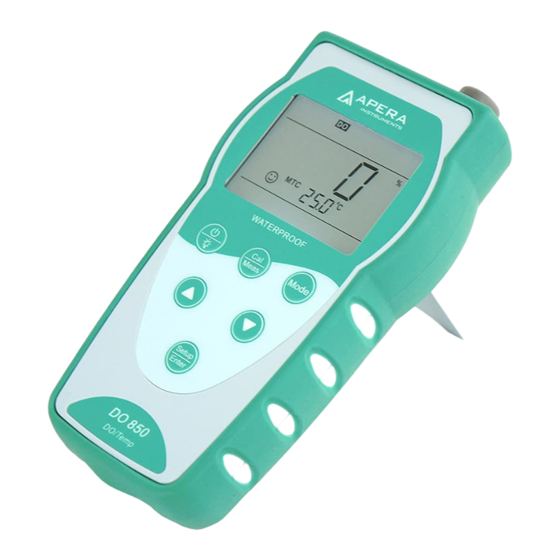
Table of Contents
Advertisement
Quick Links
Advertisement
Table of Contents

Subscribe to Our Youtube Channel
Summary of Contents for Apera DO850
- Page 1 DO850 Portable Optical Dissolved Oxygen Meter Instruction Manual - 1 -...
-
Page 2: Table Of Contents
Table of Contents 1 Overview .......................... - 3 - 2 Technical Specifications ..................... - 4 - 3 Instructions ........................ - 5 - LCD Screen ..........................- 5 - Keypads ..........................- 5 - Batteries ..........................- 6 - Instrument Socket ........................- 6 - Reading Stability Mode ......................- 7 - Auto Lock Mode ........................- 7 - Backlighting ........................... - 7 - Automatic Power-Off ......................- 7 - 4 Optical Dissolved Oxygen Probe .................. - 8 - Probe Structure ........................- 8 - Probe Maintenance ........................ - 8 - Sensor Cap ..........................- 9 - 5 Preparation for Calibration .................... - 9 - Select Dissolved Oxygen Units . -
Page 3: Overview
DO850 measures dissolved oxygen in water using luminescence technology through an optical sensor and display data with advanced intelligent instrumentation. Compared to electrochemical oxygen analyzer, DO850 is more accurate and stable, easier to use and is the most cost-effective portable optical dissolved oxygen meter. -
Page 4: Technical Specifications
Technical Specifications Dynamic Range (0-200) %; (0-20.00) mg/L Resolution 1%, 0.1mg/L (ppm) ±2% reading or ±2%saturation, whichever is greater Accuracy ±2%readin or ±0.2 mg/L, whichever is Dissolved greater Oxygen Response Time ≤30 s (25℃,90% response) Calibration Points Saturation Point & Zero Oxygen Automatic, (0 to 50)℃... -
Page 5: Instructions
Instructions 3.1 LCD Screen ① ⑦ Temperature Value/ symbol Measurement mode icon ② Reading/Measured Value ⑧ Auto lock icon Temperature Compensation ③ Symbol ATC — Auto Temperature ⑨ Compensation Units of Measurement ④ MTC — Manual Temperature Compensation ⑤ Temperature unit ⑩ Reading Stability Icon ⑥ Symbol ⑪ Low Voltage Icon 3.2 Keypads Fig.-2 - 5 -... -
Page 6: Batteries
3.2.1 Key operation Short press: key press time <2 s; long press: key press time> 2 s. Power on: Press to turn on. Shutdown: long press 2 seconds off. Table - 1 Key operations and functions Operation Functions l In the shutdown mode: press the key to boot Short Press l In measurement mode: Press to turn backlight on or off... -
Page 7: Reading Stability Mode
3.5 Reading Stability Mode When the measured value is stable, the LCD screen displays the icon as shown in Figure -4. If there is no icon or icon flashing, indicating that the measured value is not stable, the measured value should not be read or calibrated. Fig.-4 3.6 Auto Lock Mode In parameter setting P4 you can select the auto-lock mode (Off-On,... -
Page 8: Optical Dissolved Oxygen Probe
Optical Dissolved Oxygen Probe 4.1 Probe Structure The instrument DO803 optical dissolved oxygen probe which has a length 3m and built-in temperature sensor, can achieve automatic temperature compensation. The electrode structure is shown in Fig. 7 Fig.-7 1. Bottom cover of the calibration sleeve 5. -
Page 9: Sensor Cap
4.3 Sensor Cap (A) The sensor cap is an important part of the optical DO probe. The surface coating of the cap cannot be scratched or mechanically worn. Otherwise, the life of the sensor cap will be reduced or the probe will be damaged. Please pay special attention to it when using the probe. -
Page 10: Salinity Compensation
5.4 Salinity Compensation The instrument has manual salinity compensation. It is set in the parameter P2 (0 to 45 ppt). To obtain accurate readings in mg / L and ppm, it is necessary to know the salinity of the solution to be tested and input it into the instrument. As the salinity of the solution increases, the level of DO decreases. -
Page 11: Measurement
Measurement When measuring, place the probe in your sample solution, swirl quickly in the solution for a few seconds and rest it in order to remove bubbles from the measuring surface of the sensor cap. The test solution must be above the immersion line of the probe. Note that briefly shaking the probe in solution is only meant to eliminate potential bubbles on the sensor cap. - Page 12 8.2 Parameter setting (press to switch) P1—Dissolved Oxygen Unit(mg/L—ppm) 1. In the measurement mode, press the key to enter P1 mode. 2. Press the key, mg / L flashes, press the key to select mg / L → ppm, press to confirm.
-
Page 13: Complete Kit
Calibration sleeve 10 Warranty 10.1 The warranty period of the DO850 instrument (only the instrument) is 3 years from the date of purchase. That of DO803 optical DO probe (excluding sensor cap) is 2 years from the date of purchase. That of DO8032 sensor cap is 1 year from the date of purchase. -
Page 14: Trouble Shooting
(A) Fails to install, operate, or use the product in accordance with the instruction manual, or if the product is damaged by abuse or incorrect use; (B) The sensor cap is damaged by external force and can not work; or the electrode cable is damaged or twisted due to external force;... -
Page 15: Appendix A: D O % C A L I B R A T I O N Va L U E S
12 Appendix A: D O % C A L I B R A T I O N VA L U E S Chlority: 0 5.0 ppt 10.0 ppt 15.0 ppt 20.0 ppt 25.0 ppt Temp °C Salinity: 0 9.0 ppt 18.1 ppt 27.1 ppt 36.1 ppt 45.2 ppt 0.0 14.62 13.73 12.89 12.10 11.36 10.66 1.0... - Page 16 668.8 89.17 26.33 668.8 89.17 26.33 26.03 661.2 88.15 26.03 661.2 88.15 26.03 25.73 653.6 87.14 25.73 653.6 87.14 25.73 APERA INSTRUMENTS, LLC Address: 977 Old Henderson Rd, Columbus Ohio 43220 Tel: 1-614-285-3080 Email: info@aperainst.com Website: www.aperainst.com - 16 -...














Need help?
Do you have a question about the DO850 and is the answer not in the manual?
Questions and answers